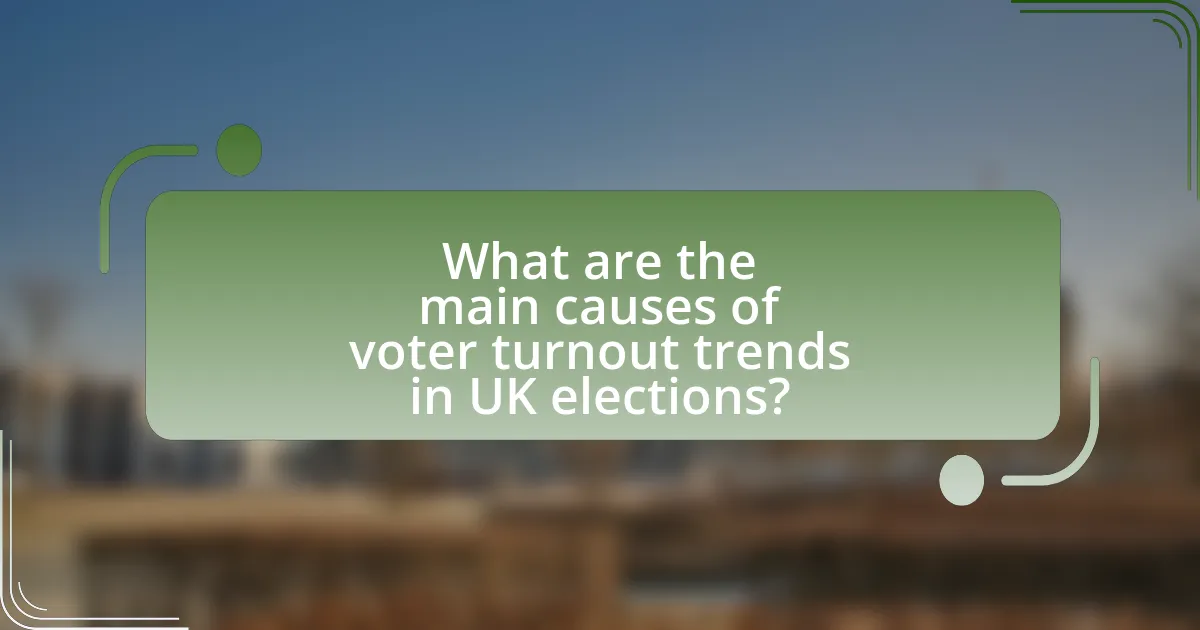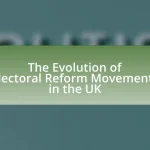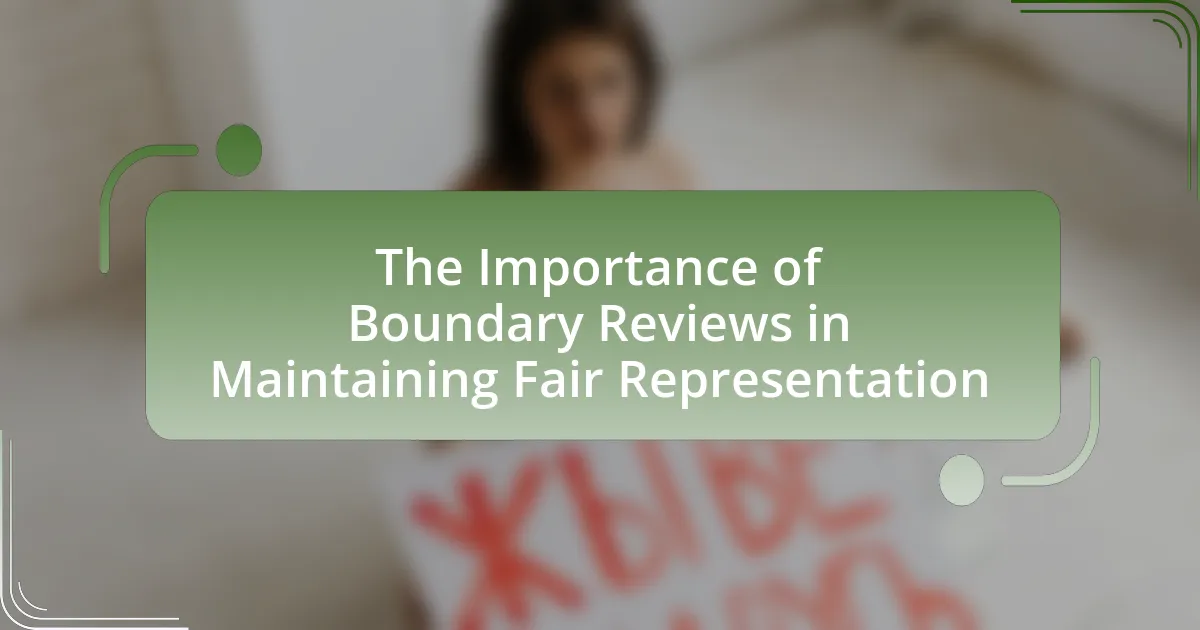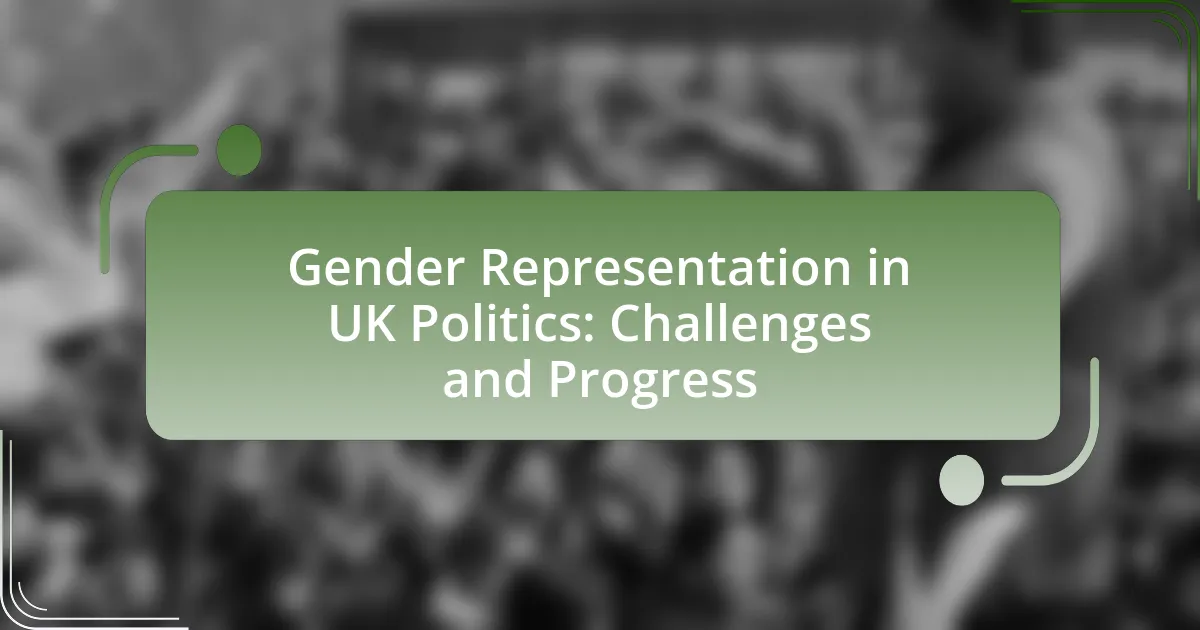The article examines voter turnout trends in UK elections, highlighting a gradual decline in participation rates, particularly among younger voters. It details historical patterns, significant fluctuations in turnout during key elections, and the influence of demographic factors such as age, socioeconomic status, and ethnicity on voter engagement. The analysis also explores the causes of these trends, including political disillusionment and the impact of media coverage, while discussing the consequences of low turnout for democratic legitimacy and policy-making. Additionally, the article suggests strategies to improve voter participation in future elections.

What are the current trends in voter turnout in UK elections?
Current trends in voter turnout in UK elections indicate a gradual decline, with the turnout for the 2019 general election at 67.3%, a decrease from 68.8% in 2017. This trend reflects a broader pattern of fluctuating engagement, particularly among younger voters, who historically show lower participation rates. The Electoral Commission reported that turnout among 18 to 24-year-olds was only 47% in 2019, compared to 66% for those aged 65 and over. Factors contributing to this decline include political disillusionment, the impact of social media, and changes in voting methods.
How has voter turnout changed over the past decades in the UK?
Voter turnout in the UK has generally declined over the past decades. For instance, turnout for general elections was approximately 83.9% in 1950, but fell to around 67.3% in the 2019 general election. This trend reflects a significant decrease in participation, with various factors such as political disillusionment and changes in voter demographics contributing to this decline. The Electoral Commission reported that turnout among younger voters has particularly decreased, highlighting a generational shift in engagement with the electoral process.
What specific elections have seen significant changes in turnout rates?
The UK general elections of 1997, 2001, and 2019 have seen significant changes in turnout rates. In 1997, turnout was approximately 71.4%, marking a high point following a period of declining participation. However, in 2001, turnout dropped to around 59.4%, the lowest since 1918, reflecting voter apathy and dissatisfaction. In contrast, the 2019 general election experienced a resurgence in turnout, reaching about 67.3%, driven by heightened political engagement and the contentious nature of Brexit. These fluctuations illustrate the impact of political context on voter participation in the UK.
How do demographic factors influence these turnout trends?
Demographic factors significantly influence voter turnout trends by affecting the likelihood of individuals participating in elections. Age is a primary demographic factor; younger voters, particularly those aged 18-24, historically exhibit lower turnout rates compared to older age groups, with the 65+ demographic often showing the highest participation rates. For instance, the 2019 UK General Election saw only 47% of 18-24-year-olds voting, while 75% of those aged 65 and over participated.
Additionally, socioeconomic status plays a crucial role; individuals from higher income brackets tend to vote at higher rates than those from lower socioeconomic backgrounds. In the 2017 UK General Election, 67% of individuals in the highest income quintile voted, compared to just 43% in the lowest quintile.
Ethnicity also impacts turnout, with minority ethnic groups often facing barriers that can lead to lower participation rates. For example, the 2019 election data indicated that Black and Asian voters had lower turnout rates compared to White voters, influenced by factors such as disenfranchisement and lack of representation.
These demographic factors collectively shape turnout trends, highlighting disparities in electoral participation across different segments of the population.
What are the historical patterns of voter turnout in the UK?
Historical patterns of voter turnout in the UK show significant fluctuations influenced by various social, political, and economic factors. For instance, turnout was notably high in the early 1950s, reaching around 83% in the 1950 general election, but has generally declined since then, with a low of approximately 59% in the 2001 election. Factors contributing to these trends include changes in electoral laws, the rise of alternative parties, and shifts in public engagement with politics. The 2019 general election saw a slight increase in turnout to about 67%, reflecting heightened public interest in key issues such as Brexit.
What events have historically impacted voter turnout rates?
Historically, significant events such as general elections, referendums, and major political scandals have impacted voter turnout rates in the UK. For instance, the 2016 Brexit referendum saw a turnout of 72.2%, which was notably higher than the 66.1% turnout in the 2015 general election, indicating that pivotal national issues can mobilize voters. Additionally, the 1997 general election, which resulted in a landslide victory for Labour, had a turnout of 71.4%, reflecting public engagement driven by the desire for change after years of Conservative rule. Political events like the 2008 financial crisis also influenced voter participation, as economic uncertainty often prompts citizens to engage more actively in the electoral process.
How do voter turnout rates in the UK compare to other countries?
Voter turnout rates in the UK are generally lower than in many other European countries. For instance, the UK’s voter turnout for the 2019 general election was approximately 67.3%, while countries like Sweden and Denmark reported turnout rates exceeding 80% in their recent elections. This trend indicates that the UK often ranks below the European average, which hovers around 75%. Factors contributing to this disparity include differences in electoral systems, voter engagement strategies, and public trust in political institutions.

What are the main causes of voter turnout trends in UK elections?
The main causes of voter turnout trends in UK elections include socioeconomic factors, political engagement, and electoral system changes. Socioeconomic factors, such as income level and education, significantly influence voter participation; for instance, higher education levels correlate with increased turnout rates. Political engagement, driven by campaign effectiveness and public interest in issues, also affects turnout; elections with compelling narratives or significant stakes tend to mobilize more voters. Additionally, changes in the electoral system, such as the introduction of voter ID laws or changes in registration processes, can either facilitate or hinder voter participation, as seen in the 2019 general election where simplified registration processes contributed to higher turnout.
How do political engagement and public interest affect voter turnout?
Political engagement and public interest significantly increase voter turnout. When individuals are actively involved in political discussions, campaigns, and civic activities, they are more likely to participate in elections. Research indicates that higher levels of political engagement correlate with increased voter participation; for instance, a study by the Electoral Commission in 2019 found that individuals who discussed politics regularly were 20% more likely to vote compared to those who did not engage in such discussions. Additionally, public interest in political issues, especially during pivotal elections, drives turnout as citizens feel their votes matter in shaping policies that affect their lives. This relationship is further supported by data showing that voter turnout in the UK reached 72.2% in the 2017 general election, a rise attributed to heightened public interest in Brexit and its implications.
What role do political campaigns play in influencing voter turnout?
Political campaigns significantly influence voter turnout by mobilizing supporters, shaping public perception, and providing information about candidates and issues. Campaigns utilize targeted messaging and outreach strategies, such as door-to-door canvassing and social media engagement, to encourage participation. Research indicates that well-organized campaigns can increase turnout by as much as 5-10%, as evidenced by the 2017 UK General Election, where Labour’s campaign efforts led to a notable rise in youth voter participation. This demonstrates that effective political campaigns are crucial in driving voter engagement and ultimately impacting election outcomes.
How does media coverage impact public perception and turnout?
Media coverage significantly influences public perception and voter turnout by shaping the narrative around elections and candidates. Extensive and positive media coverage can enhance a candidate’s visibility and appeal, leading to increased public interest and engagement. For instance, studies have shown that during the 2017 UK General Election, heightened media attention on key issues like Brexit resulted in a 2.5% increase in voter turnout compared to the previous election. Conversely, negative or biased media coverage can alienate voters and suppress turnout by fostering disillusionment or apathy. Research indicates that when media outlets focus on scandals or controversies, it can lead to a decrease in voter enthusiasm, as seen in the 2019 UK General Election, where negative coverage contributed to lower engagement among certain demographics. Thus, the nature and extent of media coverage play a crucial role in shaping both public perception and electoral participation.
What socioeconomic factors contribute to variations in voter turnout?
Socioeconomic factors significantly influence variations in voter turnout, with income level, education, and employment status being key determinants. Higher income individuals tend to vote more frequently, as they often have greater access to resources and information about the electoral process. Education plays a crucial role; studies show that individuals with higher educational attainment are more likely to participate in elections, as they possess better civic knowledge and engagement. Employment status also affects turnout; those who are employed are generally more likely to vote compared to the unemployed, as stable employment often correlates with a sense of civic responsibility and community involvement. According to the UK Electoral Commission, in the 2019 general election, voter turnout was 67.3% among those with higher education compared to just 43% among those with no formal qualifications, highlighting the impact of these socioeconomic factors on electoral participation.
How does education level correlate with voter participation?
Education level positively correlates with voter participation, as individuals with higher educational attainment are more likely to vote. Research indicates that in the UK, approximately 80% of those with a degree participated in elections, compared to around 50% of those without formal qualifications. This trend is supported by studies from the Electoral Commission, which highlight that education influences civic engagement and awareness of political issues, leading to increased likelihood of voting.
What impact does income inequality have on voter turnout?
Income inequality negatively impacts voter turnout by creating disparities in political engagement among different income groups. Research indicates that individuals from lower-income brackets are less likely to vote compared to their higher-income counterparts, primarily due to factors such as lack of resources, lower levels of political efficacy, and reduced access to information. For instance, a study by the Electoral Commission in the UK found that in the 2019 general election, voter turnout was significantly lower among those earning less than £20,000 compared to those earning over £50,000, highlighting the correlation between income levels and participation in elections.

What are the consequences of changing voter turnout trends in the UK?
Changing voter turnout trends in the UK can significantly impact electoral outcomes and the overall democratic process. Lower voter turnout often leads to a skewed representation, where the interests of a smaller, more engaged electorate dominate, potentially marginalizing broader public concerns. For instance, the 2019 general election saw a turnout of 67.3%, which was lower than previous elections, resulting in a Conservative majority that reflected the preferences of a specific demographic rather than the entire electorate. Additionally, fluctuating turnout can influence policy decisions, as elected officials may prioritize the needs of their active supporters over the wider population, leading to governance that does not accurately reflect the electorate’s diverse views.
How does low voter turnout affect the legitimacy of elections?
Low voter turnout undermines the legitimacy of elections by creating a perception that the elected representatives do not reflect the will of the majority. When fewer citizens participate in the electoral process, the resulting mandate is often viewed as weak or unrepresentative. For instance, in the 2019 UK general election, voter turnout was approximately 67.3%, which raised concerns about whether the elected government truly represented the preferences of the entire electorate. This perception can lead to decreased public trust in political institutions and increased political apathy, further exacerbating the cycle of low engagement in future elections.
What implications does low turnout have for policy-making?
Low voter turnout significantly undermines the legitimacy of policy-making. When fewer citizens participate in elections, the elected representatives may not accurately reflect the preferences of the broader population, leading to policies that cater to a smaller, potentially unrepresentative segment of society. For instance, in the 2019 UK general election, only 67.3% of registered voters cast their ballots, which raises concerns about whether the resulting government truly represents the will of the entire electorate. This disconnect can result in policies that fail to address the needs and concerns of the majority, ultimately eroding public trust in democratic institutions and processes.
How does voter apathy influence political representation?
Voter apathy significantly undermines political representation by leading to lower voter turnout, which skews the demographic and ideological composition of elected bodies. When large segments of the population abstain from voting, the elected representatives may not accurately reflect the views and needs of the entire electorate. For instance, in the 2019 UK General Election, voter turnout was approximately 67.3%, with lower participation rates among younger voters and marginalized communities, resulting in a Parliament that did not fully represent these groups’ interests. This disconnect can perpetuate policies that favor the preferences of more engaged voters, thereby exacerbating social inequalities and diminishing the overall legitimacy of the political system.
What are the potential long-term effects of declining voter turnout?
Declining voter turnout can lead to significant long-term effects on democratic governance and representation. A consistent decrease in voter participation may result in a less representative government, as elected officials may prioritize the interests of a smaller, more engaged electorate over the broader population. This can exacerbate social inequalities, as marginalized groups often have lower turnout rates, leading to policies that do not address their needs. Historical data from the UK shows that in the 2019 general election, voter turnout was 67.3%, a decline from 72.2% in 2001, indicating a trend that could undermine public trust in political institutions and decrease civic engagement over time. Additionally, lower turnout can weaken the legitimacy of electoral outcomes, making it easier for extremist parties to gain traction by appealing to disillusioned voters.
How might future elections be shaped by current turnout trends?
Current turnout trends indicate that future elections may be significantly influenced by demographic shifts and engagement strategies. For instance, the increasing participation of younger voters, who tend to favor progressive policies, suggests that political parties may adapt their platforms to appeal to this demographic. Additionally, the rise in turnout during recent elections, such as the 2019 UK General Election where turnout reached 67.3%, demonstrates a growing public interest in political engagement, which could lead to more competitive races and a focus on voter mobilization efforts. Historical data shows that higher turnout correlates with increased representation of diverse viewpoints, thereby shaping policy discussions and electoral outcomes in subsequent elections.
What strategies can be implemented to improve voter turnout?
To improve voter turnout, strategies such as implementing automatic voter registration, enhancing accessibility to polling places, and increasing voter education campaigns can be effective. Automatic voter registration has been shown to increase participation rates significantly; for instance, in Sweden, the implementation of this system led to turnout rates exceeding 80%. Enhancing accessibility, including providing transportation options and ensuring polling places are compliant with disability standards, can remove barriers for many voters. Additionally, targeted voter education campaigns that inform citizens about the voting process and the importance of their participation can lead to increased engagement, as evidenced by studies indicating that informed voters are more likely to participate in elections.
What practical steps can be taken to encourage higher voter turnout?
To encourage higher voter turnout, implementing measures such as automatic voter registration, extended voting hours, and targeted outreach campaigns can be effective. Automatic voter registration simplifies the process, as evidenced by countries like Sweden, where registration is automatic and results in over 80% turnout. Extended voting hours accommodate diverse schedules, as seen in the United States, where states that offer early voting report higher participation rates. Targeted outreach campaigns, particularly those focusing on underrepresented groups, have proven successful; for instance, the UK’s “Your Vote Matters” campaign increased awareness and engagement among young voters. These steps collectively enhance accessibility and motivation, leading to increased voter participation.




